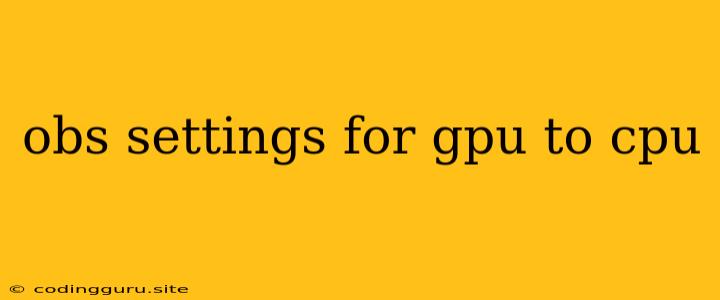Optimizing OBS for GPU and CPU Performance: A Detailed Guide
OBS Studio is a powerful and versatile tool for capturing and streaming your gameplay, screen recordings, and other content. One of the key factors in achieving smooth and high-quality recordings is optimizing the settings to balance the workload between your GPU and CPU. This guide will walk you through the most important OBS settings for optimizing both your GPU and CPU performance, ensuring you get the best possible results for your streams and recordings.
Understanding the GPU and CPU Roles in OBS
Before diving into the settings, it's essential to understand how the GPU and CPU work together within OBS.
- GPU (Graphics Processing Unit): Primarily responsible for encoding the video signal, which is the process of converting your gameplay or screen capture into a format that can be streamed or saved. It's crucial for smooth and high-quality video output.
- CPU (Central Processing Unit): Handles a variety of tasks, including audio processing, scene management, and managing the stream's communication with your streaming platform. While the CPU has a less direct role in video encoding, it's vital for overall system performance and stability.
OBS Settings to Optimize GPU Usage
Here are some key OBS settings to optimize your GPU's performance:
1. Encoder:
- x264 (Software Encoding): This is the default encoder in OBS, often utilizing your CPU for encoding. It offers more flexibility in terms of settings, but it can be resource-intensive, especially on older CPUs.
- NVENC (Hardware Encoding): For NVIDIA users, NVENC offers hardware-accelerated encoding, taking the encoding workload off your CPU and putting it on your GPU. This can significantly improve performance, especially if your CPU is not very powerful.
- AMD AMF (Hardware Encoding): Similar to NVENC, AMD AMF provides hardware-accelerated encoding for AMD graphics cards.
Tip: If you're experiencing performance issues, switching to hardware encoding (NVENC or AMF) can be a significant performance boost.
2. Encoding Preset:
- Veryfast: Offers the fastest encoding speed, but may compromise quality.
- Faster: Balances speed and quality.
- Medium: Provides a good balance of speed and quality.
- Slow: Offers the highest quality encoding, but can significantly impact performance.
- Very Slow: Primarily used for very demanding video content, requiring maximum quality at the cost of encoding speed.
Tip: Start with a Faster or Medium preset and adjust based on your system's performance and desired quality.
3. Resolution:
- Streaming at a lower resolution reduces the workload on your GPU, resulting in smoother performance.
- Tip: Experiment with different resolutions to find the best balance between quality and performance.
4. Output Mode:
- Selecting "Advanced" under "Output Mode" allows you to access more detailed settings, including the ability to fine-tune your GPU's encoding settings.
5. Downscaling Filter:
- Using a downscaling filter (e.g., Lanczos or Bilinear) can help maintain image quality while reducing the workload on your GPU during encoding.
OBS Settings to Optimize CPU Usage
While your GPU is primarily focused on encoding, your CPU plays a vital role in overall performance. These settings are crucial for optimizing your CPU usage:
1. Scene Complexity:
- Simple scenes with fewer overlays and graphics place less strain on your CPU.
- Tip: Minimize the use of resource-intensive elements such as complex transitions, custom filters, or many different sources.
2. Sources:
- Avoid capturing unnecessary sources (e.g., full desktop when only a specific window is needed).
- Tip: Only capture the content you truly need to reduce CPU workload.
3. Audio Processing:
- Reduce the number of audio sources and plugins.
- Tip: Use high-quality microphones that require less processing.
4. Performance Settings:
- Game Capture: Utilize "Capture Specific Window" instead of "Capture Entire Desktop" to reduce workload.
- Tip: Enable "Optimize Game Capture" in OBS settings for specific games.
5. CPU Usage Warning:
- Monitor your CPU usage in the "Performance" tab within OBS. If it consistently approaches 100%, consider reducing your stream's resolution, quality settings, or sources.
Additional Tips to Enhance Performance
- Optimize your System: Ensure your drivers for both your GPU and CPU are up to date.
- Close Unnecessary Programs: Minimize background programs and processes that could consume system resources.
- Hardware Upgrade: If you're still experiencing performance issues, consider upgrading your CPU, GPU, or RAM.
- Network Bandwidth: Ensure you have sufficient bandwidth for streaming.
Conclusion
Finding the perfect balance between your GPU and CPU performance in OBS involves careful consideration of your hardware capabilities and the content you're streaming or recording. By understanding the roles of your GPU and CPU, and adjusting OBS settings accordingly, you can achieve the best possible quality and smoothness for your streams and recordings. It's crucial to experiment with different settings, monitor your system's performance, and find the sweet spot that meets your needs and your hardware limitations.
